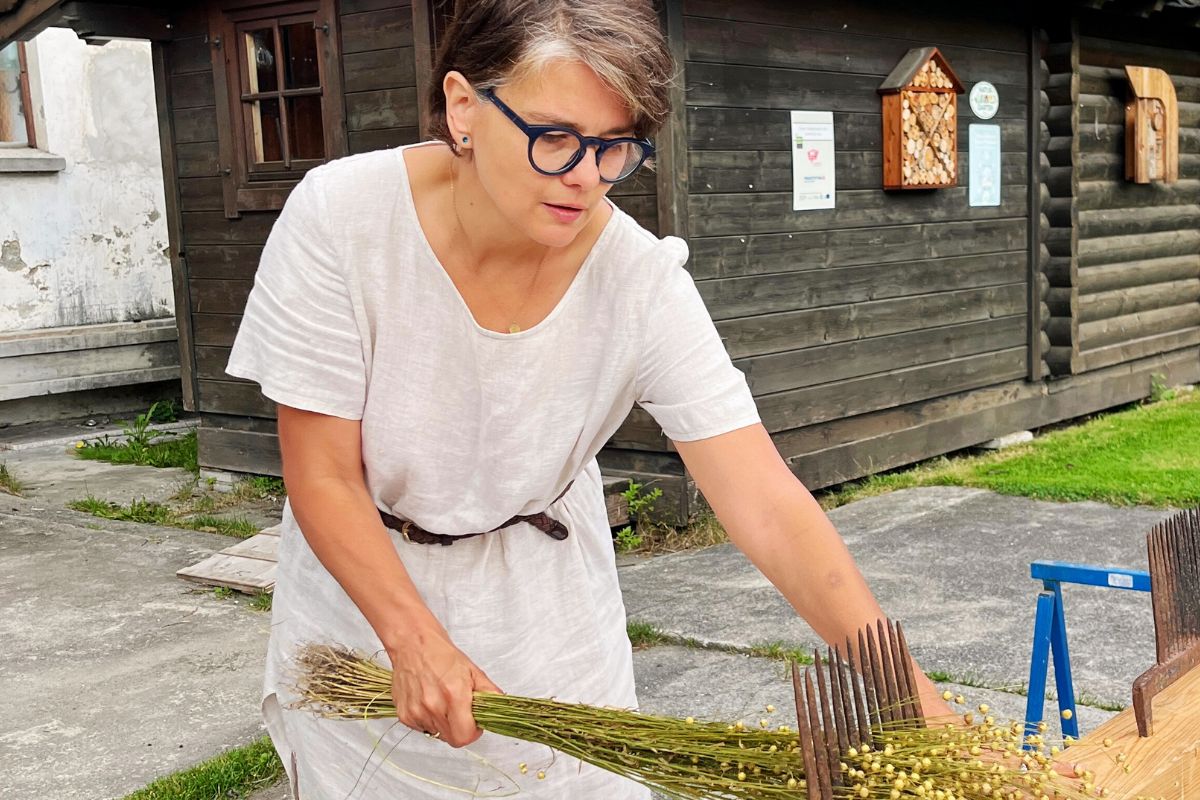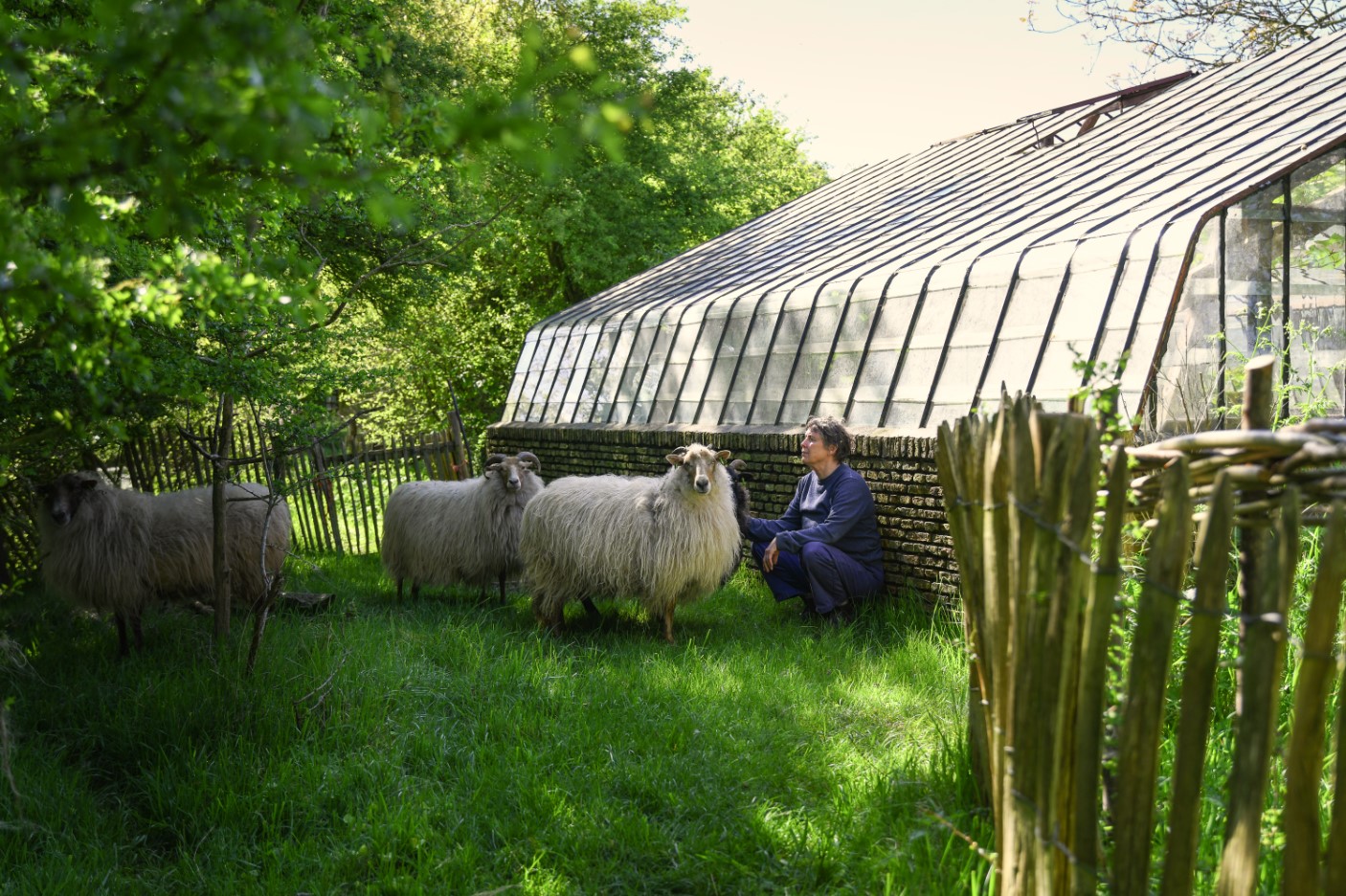Author: Valérie Záhonová • Photo: Susanne Mitterer
What drew you to the world of natural fibers and crafts in general? Was there a particular moment or experience that sparked this journey?
Ten or fifteen years ago, I had no connection to textiles. Then we bought a house in the countryside surrounded by a vast, wild landscape that needed tending. When my husband said it was too large to mow, we decided, “Let’s get sheep!” By the end of that first year, we had a pile of wool. It was my first time touching raw wool, and I immediately fell in love with its soft, beautiful texture. Determined to learn, I ordered a hand spindle and taught myself to spin. Within a year, I left my job as a journalist to lead workshops, and today, I’m a full-time crafts instructor.
You are a chairwoman of Bertas Flachs guild. What is the guild about?
In the world of textiles, it seems opportunities just keep finding me. Four years ago, I was already teaching spinning, when, in the midst of the pandemic, a gentleman reached out and said, “I have a chest full of flax. Would you like it?” Although I’d spun flax before and knew it held a rich history in my region, I was more focused on wool at the time. But free fibers? Of course, I accepted. He brought me around 80 kilos of beautifully hackled flax, and he was adamant it be put to good use— I promised him it would. Soon, I realized I could never spin 80 kilos on my own, so I started sending it out. Within a week, the chest was empty. The flax had spread all around the world, as people, isolated at home due to the pandemic, were eager to connect. I shared with each recipient the story of Berta, the woman from whom this flax had come. So this guild is about telling stories and sharing knowledge about flax.
Chest with hackled flax. Photo: Christiane Seufferlein
How did Bertas Flachs grow?
Shortly after the first chest, a friend in the local newspaper wrote about this experience, and within a week, my phone didn’t stop ringing. Many people called me, saying, “I have old flax at home that I don’t want to throw away—would you like to hear my story?” So, I began traveling through the Austrian region Mühlviertel, collecting flax chests and the stories of the people behind it. It all just unfolded naturally, and I found myself right in the heart of it…
Could you tell us more about the tradition of flax chests in Austria?
The flax chest used to be a wedding gift. It had a great value back then. It could have been used in times of crop failure or another unexpected situation as a sort of insurance. On the wedding day, the chest would accompany the bride to her new home, where it would be opened and displayed for everyone to see. The chests were typically decorated on the top. It wasn’t just practical but also a symbol of value and pride.
Has this tradition existed in other countries as well?
I’m not entirely sure, but the tradition of receiving a flax chest as a wedding gift seems to be quite regional. It’s not limited to my country specifically. I live in Austria, near the border with the Czech Republic and Germany, and this entire triangle shares similar customs. This tradition is more regional than national. Historically, this area was very poor, and flax was one of the few crops that could thrive here. The soil wasn’t particularly fertile, so flax became an essential cash crop. Farms would dedicate any land not needed for food production to growing flax, a practice common to Austria, Germany, and the Czech Republic.
Flax fibers from historical chests. Photo: Christiane Seufferlein
How old can this tradition be?
The oldest chest in my collection dates back to 1847. I often find newspapers inside these chests, which help me determine their dates. The tradition ended at different times in different places. During my travels in Bavaria, I rarely encountered people who still had these chests. In the Czech Republic, it’s harder for me to assess, as I lack the language skills to conduct thorough research with the older generation. In Austria, however, the tradition seems to have lasted the longest, into the 1940s or 1950s.
What do you do with the chests?
The first thing I do is that I photograph them to preserve a record of their original appearance. Then, I carefully remove the paper flower decorations and the flax stored inside. And as I mentioned before I share this old beautiful flax with the community around Bertas Flachs guild.
How many chests have you collected so far?
I’ve collected over 50 chests so far.
Flax can be spun even after a hundred years. Photo: Christiane Seufferlein
What motivates you in these activities?
Keeping traditions alive is essential. I believe it’s important to remember how our ancestors made clothes. While we can imagine food self-sufficiency, the concept of clothing self-sufficiency feels almost unimaginable today. People can’t fathom 'growing' a T-shirt or a skirt in their garden, yet this was common knowledge for our ancestors. Through Bertas Flachs, I’ve not only deepened my interest in materials but also in the stories they carry and the history they reveal. Understanding the story of a material connects you to it, making you more mindful about how you wear and care for it. Fast fashion, on the other hand, is the complete opposite. It’s one of the biggest challenges we face today. By sharing the stories of materials and clothing, we can raise awareness and inspire change. That’s why I’m so passionate about Bertas Flachs. It provides a platform for exploring many important topics.
The story of a material is something that another project you are involved in - 1qm Lein (1 square meter of flax) addresses. Can you share what this project is about?
The past three years of my work have been closely tied to Bertas Flachs. I traveled to Sweden to explore their flax traditions and met the people who launched this project there in 2020. The project, originally called 1KVM LIN, was initiated by the Swedish organization Hemslojden. In 2020 they started with 300 participants and in 2024 they had about 8000. I was truly inspired to see so many young people participating in it. Typically, the attendees of my craft workshops are over 50, so this was a refreshing change. I decided to bring the project to Austria with the goal of sparking the same enthusiasm for flax among all generations. The first edition will start in 2025, and I truly hope to ignite many love affairs between people and flax.
How does it work? Participants get flax seeds, grow their flax… What comes next?
I’ve created videos to guide participants through every step of the process—from growing and retting to scutching, hackling, spinning, and weaving. These tutorials are designed for everyone, including those without historical tools. I demonstrate both traditional methods and modern improvisations for people who don’t have access to specialized equipment.
Flax connects. The project 1qm Lein (one square meter of flax) will launch in Austria in 2025. Photo: Susanne Mitterer
How many people want to grow a square metre of flax?
I currently have almost 300 people registered in Austria for 2025. I originally planned to expand the project to all German-speaking countries, but I soon realized that I couldn't do it alone. So I approached my friend Mona Knorr and now we are running the project together in Austria and Germany. In Germany we now have about five hundred registrants. But we expect the numbers to grow before spring.
What are your hopes for the future of natural materials and traditional crafts?
I'm especially passionate about reviving stories from the past, particularly those of women, because they hold a profound relevance today. Returning to creating with our own hands is also important to me because it deepens that appreciation and creates a greater connection to the materials we use. I also hope we find more ways to collaborate within Europe. It’s about fostering respect for those who came before us and keeping their knowledge alive. We need to learn from our history to look to the future. Learning these stories and skills encourages a return to making things ourselves, cultivating a deeper appreciation and connection to the materials we use. I want to teach young people about the significance of materials - whether in crafts or in everyday life, like with the clothes we wear. I am sure it is a solution to know and love materials that support us!
–
Christiane Seufferlein is a craft mediator in textiles with a focus on hand spinning, natural dyeing, and fiber production. She researches linen history in Austria and beyond. She runs a company Faser und Farbe, chairs the flax guild Bertas Flachs and is dedicated to preserving the Breitenberg Weaving Museum.




%20(2)%20kopie.jpg)